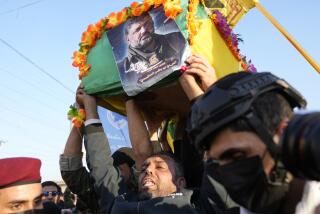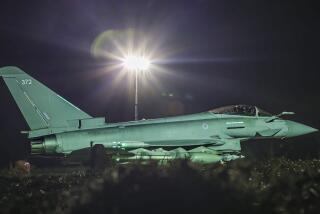U.S. airstrikes in Iraq help Kurds turn tables on Islamic State

Kurdish snipers trained their rifles on a black Islamist flag still fluttering from the top of a cellphone tower. Other peshmerga, as Kurdish forces are known, snapped selfies alongside a bullet-riddled pickup that previously was part of the mechanized fleet of the insurgent group known as the Islamic State.
“We will not back down from these terrorists, we know their tactics now,” declared a triumphant Kurdish Maj. Gen. Abdel Rahman Korini, standing on a road near the overturned pickup, flanked by mounds of dirt where the driver and his passengers were hastily interred.
Kurdish forces are advancing steadily but surely in northwestern Iraq, reversing their humiliating retreat this month. The decisive factor in the turnaround: the use of U.S. air power.
Now it is the Islamic State insurgents who are making what appears to be a tactical withdrawal to strongholds to the west and south of the strategic Mosul dam. By Monday, Kurdish commanders said, the dam was fully under Kurdish control, though roads and approaches were laced with scores of mines. President Obama later confirmed the dam’s capture in a White House address.
“If that dam was breached, it could have proven catastrophic, with floods that would’ve threatened the lives of thousands of civilians and endangered our embassy compound in Baghdad,” Obama said Monday, though he pledged that the U.S. would “not reintroduce thousands of troops” on additional missions in Iraq.
“We are not the Iraqi military,” he said. “We’re not even the Iraqi air force.”
Casualties on both sides appear to have been relatively few in the clashes leading up to the retaking of the dam. The militants opted to pull back instead of fighting to the last man.
In recent days, U.S. jets and drones have pounded the area near the sprawling dam, Iraq’s largest and a major source of power and water. The Pentagon said it conducted 15 airstrikes in the area Monday, the third consecutive day of a joint operation with Iraqi government and Kurdish forces.
Kurdish fighters, stretched thin across a long front and lacking in heavy weaponry, now have a formidable asset: the world’s most powerful airstrike capability.
The aerial attacks have provided an existential boost for the Kurds, whose standing as fearsome warriors had suffered a severe setback in recent weeks. Many peshmerga interviewed here now appear euphoric.
“We are just awaiting orders to march forward,” said Brig. Gen. Sardar Karim, standing near earthen berms west of the town of Tel Skuf that marked the front lines, southeast of the dam and just two miles from Islamic State positions — and less than 20 miles from the city of Mosul, the militant stronghold.
Plumes of smoke and the flash of machine-gun rounds were visible in the distance. Troops leaned against the earthen mounds with their rifles ready. But there was no sign of tanks, armored vehicles or heavy artillery — all items largely absent from the peshmerga arsenal. Commanders said they had seen no sign of the recent reported influx of U.S. weaponry.
There was scant safe shelter from mortar or artillery strikes along the front lines. But spirits were high among the troops, who included teenagers as well as grizzled and rotund veterans of the 1980s guerrilla battles against Saddam Hussein’s armed forces. The peshmerga were in a patchwork of uniforms; many wore green shirts with “U.S. Army” emblazoned on the front, presumably U.S.-supplied.
“I couldn’t resist the chance to fight for my homeland,” said Kazem Mahmoud, 46, who said he signed up as a volunteer recently and is thrilled to be on the front lines.
The onset of warplanes and drones has clearly forced the Islamic militants to rethink their tactic of rampaging frontal assault, heretofore so terrifying and effective, in both Iraq and Syria. Their freedom of movement has been constrained.
The Islamic State doesn’t share its military strategy with outsiders. But the new threat from the skies has left its trademark motorized columns, complete with U.S.-made Humvees looted from the Iraqi army, vulnerable to abrupt obliteration.
The black-flag-waving militants’ reputation as an indomitable juggernaut has taken a serious hit in the rolling plains outside Mosul. Their retreat here is the most significant setback for the group since the Islamist fighters launched their blitz through northern Iraq in June, stunning the world as they overran Mosul and much of northern Iraq. More recent gains in early August threatened Irbil, the capital of Iraqi Kurdistan, and sent hundreds of thousands of displaced people fleeing toward Kurdish territory, most of them minority Christians and members of the Yazidi sect. But those advances also prompted the U.S. air offensive.
“Of course the American air attacks have been very helpful,” said Korini, the Kurdish general. “We coordinate very closely with our American allies.”
Air power by itself cannot win a war, military experts caution. But events on the ground here demonstrate anew how aerial attacks in collaboration with ground forces can be a daunting dual threat, especially in open terrain.
The battle for northern Iraq remains in its early stages. Many militants appear to be pulling back to their urban stronghold of Mosul and nearby Sunni Muslim Arab towns where many residents have welcomed them.
Air power in such heavily populated districts risks many civilian casualties, which could solidify support for the militants. A Kurdish-led assault on historically Arab areas such as Mosul would certainly generate fierce resistance. Today the Kurds and their allies are celebrating a victory. But the battle against the Islamic State seems likely to be a long one, its outcome uncertain.
Times staff writer Shashank Bengali in Baghdad contributed to this report.
More to Read
Sign up for Essential California
The most important California stories and recommendations in your inbox every morning.
You may occasionally receive promotional content from the Los Angeles Times.





